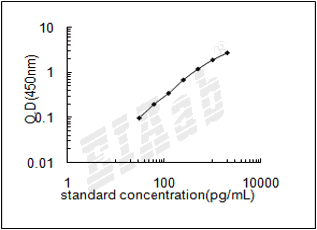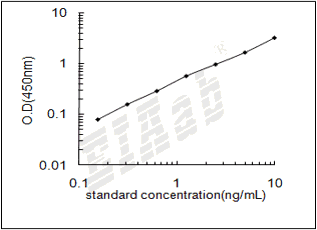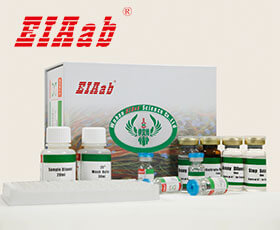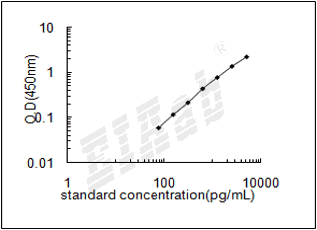Oprm1 (基因名), Mu-type opioid receptor (蛋白名), oprm_rat.
产品名称:
Rat Oprm1/ Mu-type opioid receptor CLIA Kit
μ阿片受体
货号:
U0714r
商标:
EIAab®
监管等级:
别名:
Opioid receptor B, M-OR-1, Ror-b
检测方法:
CLIA
实验类型:
Sandwich
检测范围:
31.2-2000pg/mL
特异性:
Natural and recombinant rat Mu-type opioid receptor
样品类型:
Serum, plasma, tissue homogenates, cell culture supernates and other biological fluids
样品数据:
登录.
研究领域:
Neurosciences
通用注释
亚单元:
Forms homooligomers and heterooligomers with other GPCRs, such as OPRD1, OPRK1, OPRL1, NPFFR2, ADRA2A, SSTR2, CNR1 and CCR5 (probably in dimeric forms) (PubMed:10842167, PubMed:11896051, PubMed:14645661, PubMed:14729105, PubMed:17384143, PubMed:16682964). Interacts with heterotrimeric G proteins; interaction with a heterotrimeric complex containing GNAI1, GNB1 and GNG2 stabilizes the active conformation of the receptor and increases its affinity for endomorphin-2, the synthetic opioid peptide DAMGO and for morphinan agonists (By similarity). Interacts with PPL; the interaction disrupts agonist-mediated G-protein activation. Interacts (via C-terminus) with DNAJB4 (via C-terminus). Interacts with calmodulin; the interaction inhibits the constitutive activity of OPRM1; it abolishes basal and attenuates agonist-stimulated G-protein coupling (By similarity). Interacts with FLNA, PLD2, RANBP9 and WLS and GPM6A (PubMed:12519790, PubMed:17548356). Interacts with RTP4 (By similarity). Interacts with SYP and GNAS (PubMed:15857684, PubMed:17005904). Interacts with RGS9, RGS17, RGS20, RGS4, PPP1R9B and HINT1.
功能:
Receptor for endogenous opioids such as beta-endorphin and endomorphin. Receptor for natural and synthetic opioids including morphine, heroin, DAMGO, fentanyl, etorphine, buprenorphin and methadone. Agonist binding to the receptor induces coupling to an inactive GDP-bound heterotrimeric G-protein complex and subsequent exchange of GDP for GTP in the G-protein alpha subunit leading to dissociation of the G-protein complex with the free GTP-bound G-protein alpha and the G-protein beta-gamma dimer activating downstream cellular effectors. The agonist- and cell type-specific activity is predominantly coupled to pertussis toxin-sensitive G(i) and G(o) G alpha proteins, GNAI1, GNAI2, GNAI3 and GNAO1 isoforms Alpha-1 and Alpha-2, and to a lesser extend to pertussis toxin-insensitive G alpha proteins GNAZ and GNA15. They mediate an array of downstream cellular responses, including inhibition of adenylate cyclase activity and both N-type and L-type calcium channels, activation of inward rectifying potassium channels, mitogen-activated protein kinase (MAPK), phospholipase C (PLC), phosphoinositide/protein kinase (PKC), phosphoinositide 3-kinase (PI3K) and regulation of NF-kappa-B. Also couples to adenylate cyclase stimulatory G alpha proteins. The selective temporal coupling to G-proteins and subsequent signaling can be regulated by RGSZ proteins, such as RGS9, RGS17 and RGS4. Phosphorylation by members of the GPRK subfamily of Ser/Thr protein kinases and association with beta-arrestins is involved in short-term receptor desensitization. Beta-arrestins associate with the GPRK-phosphorylated receptor and uncouple it from the G-protein thus terminating signal transduction. The phosphorylated receptor is internalized through endocytosis via clathrin-coated pits which involves beta-arrestins. The activation of the ERK pathway occurs either in a G-protein-dependent or a beta-arrestin-dependent manner and is regulated by agonist-specific receptor phosphorylation. Acts as a class A G-protein coupled receptor (GPCR) which dissociates from beta-arrestin at or near the plasma membrane and undergoes rapid recycling. Receptor down-regulation pathways are varying with the agonist and occur dependent or independent of G-protein coupling. Endogenous ligands induce rapid desensitization, endocytosis and recycling. Heterooligomerization with other GPCRs can modulate agonist binding, signaling and trafficking properties. Involved in neurogenesis.
亚细胞位置:
Cell membrane
Multi-pass membrane protein
Cell projection
Axon
Perikaryon
Cell projection
Dendrite
Endosome
Is rapidly internalized after agonist binding.
该产品尚未在任何出版物中被引用。
反馈墙
评论数 : 0
所有用户
所有用户
默认排序
默认排序
最近
早期
目前还没有评论。






通知
规格
数量
单价 (¥)
小计 1 (¥)
小计 2:
¥

规格
数量
单价 (¥)









 验证序列:
验证序列:




 折扣:
折扣: